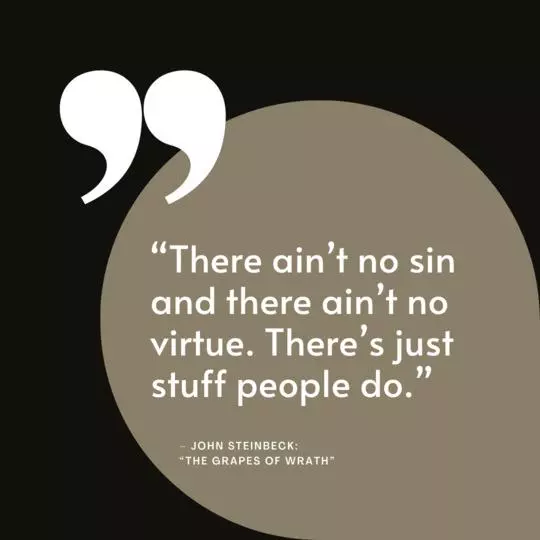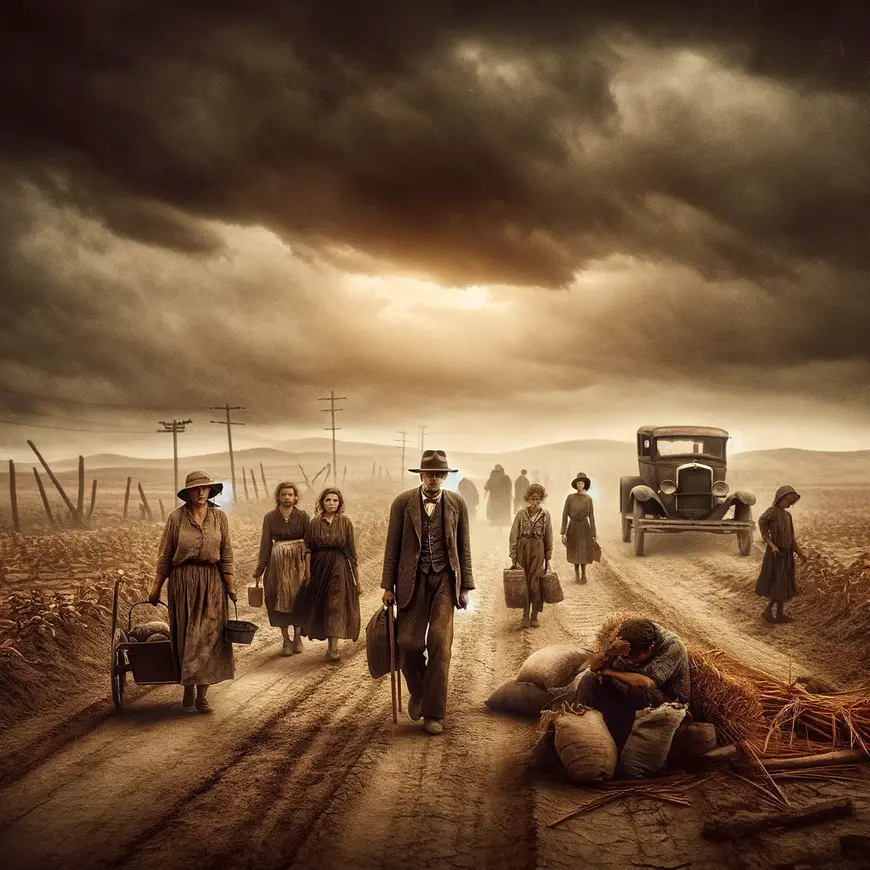The Grapes of Wrath: John Steinbeck’s Masterpiece that captivate readers with its timeless themes
My Thoughts on The Grapes of Wrath by John Steinbeck
I was deeply intellectually challenged by my reading of John Steinbecks “The Grapes of Wrath.” From the start the struggles faced by the Joad family captivated me. Steinbecks detailed depiction of their journey, from Oklahoma to California vividly portrayed the realities of the Dust Bowl era. Their mix of despair and optimism in the face of challenges resonated with me.
The themes of poverty, injustice and human dignity struck a chord within me. Each obstacle that befell the family stirred up a blend of anger and sorrow shedding light on the harshness of their world. Steinbeck’s depiction of their fight for survival and quest for a future prompted me to ponder on the resilience in human nature.
The stark imagery of landscapes and overcrowded often unwelcoming camps lingered in my mind. I could almost sense the dust swirling around me feel the heat and perceive the tension hanging in the air. The novels portrayal of solidarity among those marginalized was both inspiring and heartrending. On a level it spurred contemplation on issues like justice and empathy. “The Grapes of Wrath” left an impact, on me underscoring how literature has the power to evoke emotional and intellectual responses.
“The Grapes of Wrath” by John Steinbeck is an epic novel that powerfully captures the struggles and resilience of the American working class during the Great Depression. Published in 1939, this literary masterpiece continues to captivate readers with its vivid portrayal of the Joad family’s journey from Oklahoma to California in search of a better life. With its searing social commentary, evocative imagery, and profound themes of injustice, humanity, and the indomitable spirit of the human condition, “The Grapes of Wrath” remains a timeless work of American literature. This review delves into the novel’s impact, narrative prowess, and enduring relevance.
A Glimpse of the Great Depression:
“The Grapes of Wrath” serves as a searing indictment of the social and economic injustices endured by the working class during the Great Depression. Steinbeck paints a bleak and harrowing picture of the Dust Bowl era, as farmers in the Midwest are driven from their lands by drought and the ruthless banks that foreclose on their homes. The novel explores the systemic failures and inequality that pervaded society, while highlighting the resilience and dignity of those who suffered the most.
At the heart of the novel is the Joad family, led by Tom Joad, who returns to his family’s farm after serving time in prison. As the Joads are forced to leave their land, they embark on a treacherous journey to California in search of work and a chance at a better life. Steinbeck presents a vivid and unflinching portrayal of the hardships faced by migrant workers, including poverty, exploitation, and discrimination. Through the Joads’ trials and triumphs, the novel explores the indomitable spirit of human resilience and the enduring power of familial bonds.

Themes of Injustice and Humanity in “The Grapes of Wrath”
“The Grapes of Wrath” shines a harsh light on the social injustices and economic disparities of the time. Steinbeck exposes the greed and callousness of corporations, banks, and landowners who exploit vulnerable workers for their own profit. The novel examines the dehumanizing effects of poverty, displacement, and desperation, while also emphasizing the innate human capacity for compassion, solidarity, and hope. The juxtaposition of humanity and inhumanity serves as a poignant reminder of the power of collective action and the potential for change.
Steinbeck’s narrative skill is evident in his rich and evocative prose. His vivid descriptions transport readers to the dusty plains of Oklahoma, the hardscrabble camps of migrant workers, and the desolate highways of their journey. The author’s meticulous attention to detail brings the setting to life, creating a tangible sense of time and place. Furthermore, Steinbeck’s ability to seamlessly weave together individual stories with broader social commentary is a testament to his storytelling prowess.
Characterization:
The characters in “The Grapes of Wrath” are multifaceted and compelling, reflecting the diverse experiences and struggles of the time. From Tom Joad, the ex-convict turned advocate for social justice, to Ma Joad, the resilient matriarch who holds her family together, each character embodies a unique aspect of the human experience. The Joad family’s strength, resilience, and unwavering determination in the face of adversity make them relatable and emblematic of the struggles faced by countless families during the Great Depression.
Impact and Enduring Relevance:
“The Grapes of Wrath” had an immediate and profound impact upon its publication. It won the Pulitzer Prize for Fiction in 1940 and solidified Steinbeck’s reputation as a master storyteller. The novel sparked both critical acclaim and controversy, with some accusing it of being too political or inciting social unrest. However, its enduring relevance lies in its ability to resonate with readers across generations.
The themes explored in “The Grapes of Wrath” remain relevant today, as issues of income inequality, labor exploitation, and social justice continue to plague society. The novel serves as a powerful reminder of the importance of empathy, compassion, and collective action in the face of injustice. Its exploration of the human spirit and the enduring power of hope make it a literary touchstone for those seeking to understand the struggles and triumphs of the working class.
Famous Quotes from “The Grapes of Wrath” by John Steinbeck
- “I’ll be everywhere – wherever you look. Wherever there’s a fight, so hungry people can eat, I’ll be there. Wherever there’s a cop beatin’ up a guy, I’ll be there. … I’ll be in the way guys yell when they’re mad – I’ll be in the way kids laugh when they’re hungry and they know supper’s ready. And when the people are eatin’ the stuff they raise and livin’ in the houses they build – I’ll be there, too.”
- “Tommy, don’t you go fightin’ ’em alone. They’ll hunt you like a coyote.”
- “There ain’t no sin and there ain’t no virtue. There’s just stuff people do. It’s all part of the same thing.”
- “And the great owners, who must lose their land in an upheaval, the great owners with access to history, with eyes to read history and to know the great fact: when property accumulates in too few hands it is taken away. And that companion fact: when a majority of the people are hungry and cold they will take by force what they need.”
- “A fella ain’t got a soul of his own, but on’y a piece of a big soul. The one big soul that belongs to everybody.”
- “You’re bound to get idears if you go thinkin’ about stuff.”
- “Muscles aching to work, minds aching to create – this is man.”

Trivia Facts from “The Grapes of Wrath”
- Pulitzer Prize Winner: “The Grapes of Wrath” was awarded the Pulitzer Prize for Fiction in 1940, a year after its publication, recognizing its profound impact on American literature.
- Controversial Reception: Upon its release, the book was both highly praised and heavily criticized. It was banned and burned in several cities across the United States, including St. Louis, Missouri, and Kern County, California—the setting of much of the book’s action—due to its portrayal of harsh working conditions, poverty, and its critique of capitalism.
- Inspiration for the Title: The title of the novel is derived from “The Battle Hymn of the Republic” by Julia Ward Howe. The line “Mine eyes have seen the glory of the coming of the Lord: He is trampling out the vintage where the grapes of wrath are stored” inspired Steinbeck’s choice of title, reflecting the themes of justice and the fierce indignation at the heart of the book.
- Real-Life Inspirations: Steinbeck was inspired by the real-life conditions he observed in migrant labor camps. He spent time working with and interviewing migrants in California, and his observations significantly informed the characters and situations in the novel.
- FBI Scrutiny: John Steinbeck came under the scrutiny of the FBI because of the socialist themes and the advocacy for the working class found in “The Grapes of Wrath.” J. Edgar Hoover, then director of the FBI, personally disliked Steinbeck’s views, leading to an investigation into whether Steinbeck was a communist.
- Impact on Legislation: The novel played a significant role in bringing national attention to the plight of migrant farmworkers and the conditions in the Dust Bowl region. It influenced the creation of laws to help improve the lives of workers, including changes in labor laws and policies related to farmworkers’ rights and welfare.
- Nobel Prize: Steinbeck was awarded the Nobel Prize in Literature in 1962, partially due to the impact of “The Grapes of Wrath” on American and world literature. The Nobel committee cited “his realistic and imaginative writings, combining as they do sympathetic humour and keen social perception.”
- Film Adaptation: The novel was adapted into a critically acclaimed film directed by John Ford and released in 1940, the year after the novel’s publication. The film, which starred Henry Fonda as Tom Joad, won two Academy Awards and further solidified the story’s place in American culture.
Conclusion: “The Grapes of Wrath”
“The Grapes of Wrath” by John Steinbeck is a masterwork of American literature that continues to captivate readers with its timeless themes, vivid storytelling, and profound social commentary. Through the Joad family’s journey, Steinbeck sheds light on the injustices endured by the working class during the Great Depression while highlighting the resilience and humanity that persist in the face of adversity. The novel’s narrative prowess and enduring relevance cement its place as a seminal work that stands as a testament to the indomitable spirit of the human condition.
Other Reviews of Works by John Steinbeck
“Cannery Row” by John Steinbeck: A Heartfelt Novel to the Beauty of Imperfection What I take away from Cannery Row…
A Review of John Steinbeck’s Epic “East of Eden” : the Heartland of Humanity Steinbeck’s Magnum Opus – Navigating the…
A Journey into Youth, Dreams, and Realities – A Review of “The Red Pony” by John Steinbeck Steinbeck’s Bittersweet Tale…
A Whimsical Tale of Friendship and Misadventures: “Tortilla Flat” by John Steinbeck “Tortilla Flat” by American Author and Nobel Laureate…
A Heartrending Tale of Friendship and Dreams – “Of Mice and Men” by John Steinbeck In the vast expanse of…




